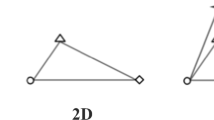Abstract
We report a quantitative structure–property relationship (QSPR) study regarding LogP. The text includes some comments regarding the influence of diversity of molecules on results of QSPR computation. The calibration (training) set was selected, according to specific molecular diversity/similarity criteria, from certain group of 621 molecules, without oxygen and nitrogen atoms. The calibration set includes 211 molecules (hydrocarbons, halo-derivatives, thioethers, phosphines etc.) having much higher diversity from the point of view of chemical structure, size, shape and lipophilicity. The validation set includes the non-selected 410 molecules. The observed value of LogP is within (0.20, 9.14) range in calibration set and within (1.08, 9.36) range in prediction/validation set. The best QSPR multilinear formula includes three quantum mechanics descriptors and does not include molecular fragments’ descriptors. For calibration set, the predictive power of QSPR is high (r 2 = 0.9489; SEE = 0.4117), close to KOWWIN (r 2 = 0.9545; SEE = 0.3961) and miLogP (r 2 = 0.9477; SEE = 0.4736) results. The predictor ‘conductor-like screening model area’ has largest influence on the value of LogP. The quality of prediction for validation set is good (r 2 = 0.9517; SEE = 0.4334), close to result obtained by KOWWIN (r 2 = 0.9676, SEE = 0.3286) and miLogP (r 2 = 0.9612; SEE = 0.4776).







Similar content being viewed by others
References
J. Bruijn, F. Busser, W. Seinen, J. Hermens, Environ. Toxicol. Chem. 8, 499 (1989)
N. Tayar, A. Mark, R.-S. Tsai, P. Vallat, C. Altomare, B. Testa, J. Chromatogr. 181, 556 (1991)
K. Valko, J. Chromatogr. 1037 A, 299 (2004)
S.M. Ulmeanu, H. Jensen, G. Bouchard, P.A. Carrupt, H.H. Girault, Pharm. Res. 20, 1317 (2003)
C. Hansch, J.E. Quinlan, G.L. Lawrence, J. Org. Chem. 33, 347 (1968)
A. Leo, C. Hansch, D. Elkins, Chem. Rev. 71, 525 (1971)
R.F. Rekker, G.G. Nys, Eur. J. Med. Chem. 9, 361 (1974)
R.F. Rekker, H.M. de Kort, Eur. J. Med. Chem. 14, 479 (1979)
L. Tarko, ARKIVOC xiv, 74 (2004)
http://www.acdlabs.com/products/phys_chem_lab/logp/competit1.html. Accessed October 2013
http://www.epa.gov/oppt/exposure/pubs/episuitedl.htm. Accessed October 2013
W.M. Meylan, P.H. Howard, J. Pharm. Sci. 84, 83 (1995)
R. Wang, Y. Fu, L.J. Lai, Chem. Inf. Comput. Sci. 37, 615 (1997)
P. Gaillard, P.A. Carrupt, B. Testa, A. Boudon, J Comput. Aided Mol. Des. 8, 83 (1994)
A.K. Ghose, V.N. Viswanadhan, J.J. Wendoloski, J. Phys. Chem. 102, 3762 (1998)
I. Moriguchi, S. Hirono, I. Nakagome, H. Hirano, Chem. Pharm. Bull. 42, 976 (1994)
http://www.molinspiration.com/. Accessed June 2014
P.G. Anoaica, E. Amzoiu, M.-B. Anoaica, L. Giubelan, Curr. Health Sci. J. 35, 1 (2009)
M. Muehlbacher, A. El Kerdawy, C. Kramer, B. Hudson, T. Clark, J. Chem. Inf. Model. 51, 2408 (2011)
E.R.M. Albelo, Y.M. Ponce, S.J. Barigye, Y.E. Díaz, F.P. Giménez, J. Mex. Chem. Soc. 57, 61 (2013)
R. Kiralj, M.M.C. Ferreira, J. Braz. Chem. Soc. 20, 770 (2009)
N. Goudarzi, M.J. Goudarzi, Braz. Chem. Soc. 21, 1776 (2010)
P. Gramatica, P. Pilutti, E. Papa, SAR QSAR Environ. Res. 13, 743 (2002)
P. Gramatica, P. Pilutti, E. Papa, QSAR Comb. Sci. 22, 364 (2003)
D.M. Hawkins, S.C. Basak, D.J. Mills, Chem. Inf. Comp. Sci. 43, 579 (2003)
C. Helma, SAR QSAR Environ. Res. 15, 367 (2004)
P. Gramatica, QSAR Comb. Sci. 26, 694 (2007)
P.P. Roy, S. Paul, I. Mitra, K. Roy, Molecules 14, 1660 (2009)
P. Gramatica, P. Pilutti, Report in Joint Research Centre (European Commission), contract ECVA-CCR 496576-Z
http://www.chem.sis.nlm.nih.gov/chemidplus/. Accessed October 2013
J.J. Gajewski, K.E. Gilbert, PCModel. Serena Software, Bloomington
http://www.openmopac.net/. Accessed October 2013
J.J.P. Stewart, J. Mol. Model. 13, 1173 (2007)
PRECLAV program is available from author
L. Tarko, C.T. Supuran, Bioorg. Med. Chem. 21, 1404 (2013)
L. Tarko, J. Math. Chem. 52, 948 (2014)
L. Tarko, ARKIVOC xi, 24 (2008)
L. Tarko, Rev. Chim. 55, 539 (2004)
A. Klamt, G.J. Schüürmann, Chem. Soc. Perkin Trans. 2 5, 799 (1993)
L. Tarko, S. Calafeteanu, Rev. Chim. 49, 169 (1998)
Author information
Authors and Affiliations
Corresponding author
Electronic supplementary material
Below is the link to the electronic supplementary material.
13738_2014_490_MOESM1_ESM.xls
Supplementary material 1 Supplementary information: The chemical structures, the statistical features of database, the observed and the computed values of LogP, using PRECLAV, EPISuite and miLogP, are included in supplementary material (XLS 135 kb)
Rights and permissions
About this article
Cite this article
Tarko, L. QSPR for LogP using molecules without oxygen and nitrogen and quantum mechanics descriptors. J IRAN CHEM SOC 12, 359–365 (2015). https://doi.org/10.1007/s13738-014-0490-y
Received:
Accepted:
Published:
Issue Date:
DOI: https://doi.org/10.1007/s13738-014-0490-y




